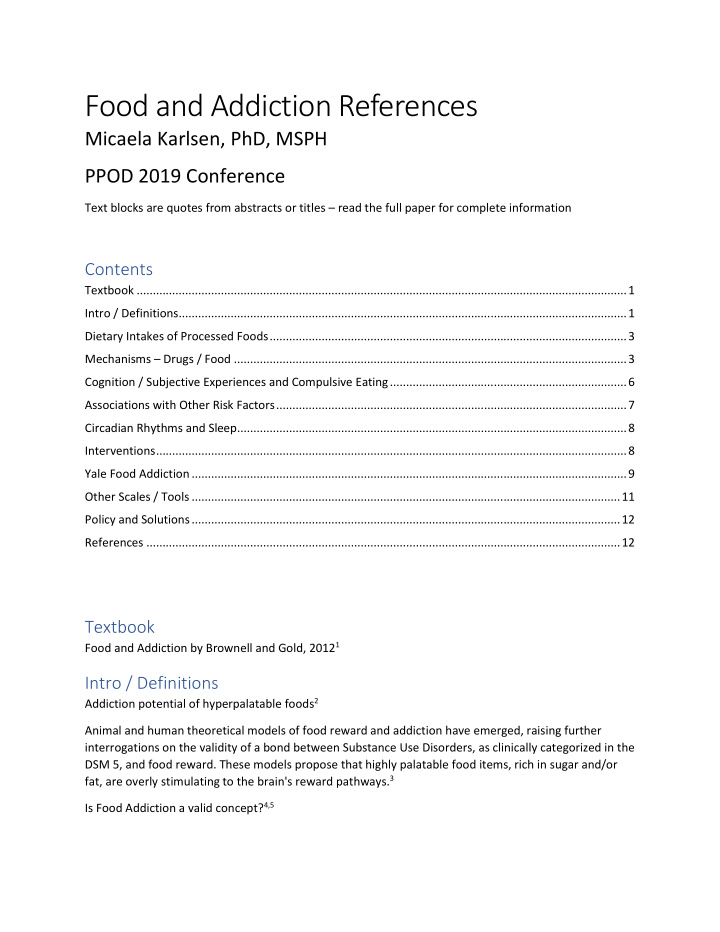



Food and Addiction References Micaela Karlsen, PhD, MSPH PPOD 2019 Conference Text blocks are quotes from abstracts or titles – read the full paper for complete information Contents Textbook ....................................................................................................................................................... 1 Intro / Definitions .......................................................................................................................................... 1 Dietary Intakes of Processed Foods .............................................................................................................. 3 Mechanisms – Drugs / Food ......................................................................................................................... 3 Cognition / Subjective Experiences and Compulsive Eating ......................................................................... 6 Associations with Other Risk Factors ............................................................................................................ 7 Circadian Rhythms and Sleep ........................................................................................................................ 8 Interventions ................................................................................................................................................. 8 Yale Food Addiction ...................................................................................................................................... 9 Other Scales / Tools .................................................................................................................................... 11 Policy and Solutions .................................................................................................................................... 12 References .................................................................................................................................................. 12 Textbook Food and Addiction by Brownell and Gold, 2012 1 Intro / Definitions Addiction potential of hyperpalatable foods 2 Animal and human theoretical models of food reward and addiction have emerged, raising further interrogations on the validity of a bond between Substance Use Disorders, as clinically categorized in the DSM 5, and food reward. These models propose that highly palatable food items, rich in sugar and/or fat, are overly stimulating to the brain's reward pathways. 3 Is Food Addiction a valid concept? 4,5
The feeding process is required for basic life, influenced by environment cues and tightly regulated according to demands of the internal milieu by regulatory brain circuits. Although eating behaviour cannot be considered "addictive" under normal circumstances, people can become "addicted" to this behaviour, similarly to how some people are addicted to drugs. The symptoms, cravings and causes of "eating addiction" are remarkably similar to those experienced by drug addicts, and both drug-seeking behaviour as eating addiction share the same neural pathways. However, while the drug addiction process has been highly characterised, eating addiction is a nascent field. In fact, there is still a great controversy over the concept of "food addiction". 6 Prospective evidence of both reward surfeit and reward deficit pathways to increased body weight are evaluated, and we argue that it is more complex than an either/or scenario when examining DA's role in reward sensitivity, eating, and obesity. The Taq1A genotype is a common thread that ties the contrasting models of DA reward and obesity; this genotype related to striatal DA is not associated with obesity class per se but may nevertheless confer an increased risk of weight gain. We also critically examine the concept of so-called food addiction, and despite growing evidence, we argue that there is currently insufficient human data to warrant this diagnostic label. 7 Here, we review the neuroimaging literature to consider the validity of food addiction and the common neurobiological mechanisms that overlap in food and drug addiction. This review paper focuses on findings from Positron Emission Tomography (PET), functional Magnetic Resonance Imaging (fMRI) and structural imaging studies, as well as evidence from neuroimaging studies of bariatric surgery and pharmacological interventions on obese individuals. We examine not only functional and structural changes in the mesolimbic pathways, but also in other frontal areas shown to be involved in drug addiction, including the prefrontal cortex, orbitofrontal cortex and anterior cingulate cortex, as well as changes in neurotransmitter systems beyond dopaminergic systems. 8 Introducing food addiction as a new disorder in diagnostic classification system seems redundant as most individuals with an addiction-like eating behavior are already covered by established eating disorder diagnoses. Food addiction may be a useful metaphor in the treatment of binge eating, but would be inappropriate for the majority of obese individuals. Implying an addiction to certain foods is not necessary when applying certain approaches inspired by the addiction field for prevention and treatment of obesity. The usefulness of abstinence models in the treatment of eating disorders and obesity needs to be rigorously tested in future studies. Some practical implications derived from the food addiction concept provide promising avenues for future research (e.g., using an addiction framework in the treatment of binge eating or applying abstinence models). For others, however, the necessity of implying an addiction to some foods needs to be scrutinized. 9 Investigators at all levels have been looking for factors that have contributed to the development of this epidemic. Two major theories have been proposed: (1) sedentary lifestyle and (2) variety and ease of inexpensive palatable foods. In the present review, we analyze how nutrients like sugar that are often used to make foods more appealing could also lead to habituation and even in some cases addiction thereby uniquely contributing to the obesity epidemic. We review the evolutionary aspects of feeding and how they have shaped the human brain to function in "survival mode" signaling to "eat as much as you can while you can." This leads to our present understanding of how the dopaminergic system is involved in reward and its functions in hedonistic rewards, like eating of highly palatable foods, and drug addiction. We also review how other neurotransmitters, like acetylcholine, interact in the satiation
Recommend
More recommend